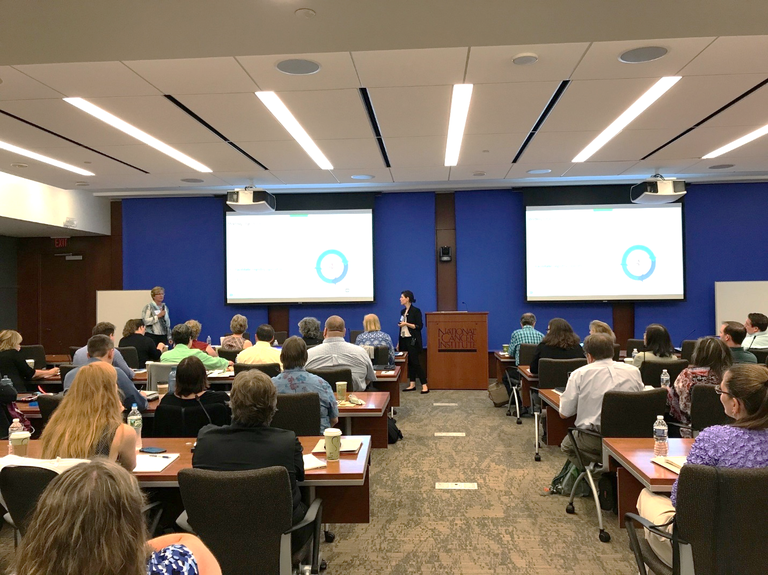
On July 12-14, 2017, the Surveillance, Epidemiology, and End Results Data Management System (SEER*DMS) 2017 Face-to-Face Meeting took place in Rockville, MD, at the National Cancer Institute’s (NCI) Shady Grove campus. The purpose of the meeting was to discuss enhancements to SEER*DMS and updates to SEER program initiatives. SEER*DMS is a centrally designed data management system that allows registries to submit cancer data to the SEER program. Developed in 2000 and first deployed in 2005, SEER*DMS also provides support for all core cancer registry functions, including importing, editing, linking, and consolidating data and producing reports. Since 2011, the SEER program has taken steps to invest in and implement enhancements to SEER*DMS. In 2015, health informatics experts conducted a review of SEER*DMS and provided several recommendations for enhancement.
One recommendation included increasing transparency and clarity of changes and enhancements coming to SEER*DMS, and involving registries in these processes. SEER registries already play an active role in identifying requirements for enhancements to SEER*DMS. These enhancements will improve data quality and consistency, reduce duplication of effort within system maintenance and administration, and improve cost efficiency. To ensure SEER*DMS users have clarity and are engaged in SEER*DMS enhancements, the NCI will host an annual meeting – the SEER*DMS Face-to-Face Meeting – to achieve this goal.
In its first year, more than 150 attendees participated in the SEER*DMS 2017 Face-to-Face Meeting in person or online. Nineteen registries were represented at the meeting in person. Participants contributed to the technical findings, summarized below, on data automation, integrating certain tools, and data quality improvement.
Considering Manual vs. Automated Processes
Currently, SEER registries use primarily manual methods to consolidate cancer data. Discussions at the Face-to-Face Meeting revealed that registries would like to move towards more automatic data consolidation, although there are still questions on how to implement this while ensuring continued high quality of data processing. Typically, workgroups—consisting of SEER registries and SEER*DMS administrators—are formed to solve problems such as this. An auto-consolidation workgroup and two other workgroups focused on automation within claims data and Meaningful Use Stage 2 data currently exist. During the Face-to-Face Meeting, participants proposed a new workgroup to enhance auto-linking processes in SEER*DMS.
Proposing New Tools
Discussions at the Face-to-Face Meeting focused on two tools proposed for integration into SEER*DMS—Case Uploader and Report Writer. Case Uploader would provide a way to validate and assess the completeness of data submitted by facilities to registries. The Report Writer tool would allow registries to produce customized reports to review registry activities, track data processing, review quality control metrics, and more. Two related workgroups focused on casefinding and the Case Uploader tool were proposed during the Face-to-Face Meeting to determine the requirements needed to develop and implement these tools within SEER*DMS.
Improving Data Quality
Face-to-Face Meeting participants also discussed improving data quality in SEER*DMS, including the proposal of three new workgroups: 1) SEER*DMS quality processes, 2) SEER*DMS quality control for rare tumors, and 3) data governance. These findings and new workgroups will allow for additional discussions to enhance tools and processes for the registry community and to improve the SEER*DMS infrastructure.
Looking Ahead
In conclusion, the SEER*DMS Face-to-Face Meeting provided registries the opportunity to share knowledge and experiences among one another and to provide feedback to the SEER program on SEER*DMS enhancements and other initiatives. Meeting discussions focused on data automation, integrated tools, and data quality improvement. These enhancements aim to augment the SEER*DMS platform to expand registries’ ability to collect, track, and process incoming cancer data and produce reports on registry operations or feedback on data submission quality. The SEER*DMS Change Control Board met in September, and workgroups are working on defining short-, mid-, and long-term goals and objectives. NCI will review the goals and objectives and work with the registries to prioritize activities to implement forthcoming SEER*DMS enhancements.

There were more than 60 in-person participants at the SEER*DMS Face-to-Face Meeting (pictured here outside of the NCI Shady Grove building). This included representatives from NCI, SEER partners, and registries from across the nation. They gathered to discuss SEER program initiatives and enhancements to the SEER*DMS platform.
